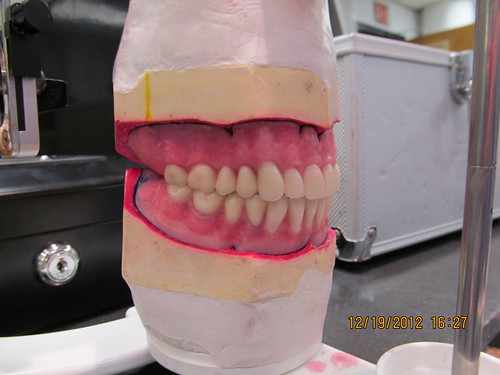Setup of Mandibular teeth
1. Heat the wax 7A carver to remove wax for the maxillary anterior teeth. Use the midline and high lip line as guidance. Use the Trubyte Occlusion Plane for assistance.
2. Set in the right and left Central Incisor. The neck of both Central Incisors are depressed.
3. Set in the right and left Lateral Incisor. Both Lateral Incisor should be 1mm higher than Central Incisor and Canines. Both Lateral Incisor should have a distal tilt.
4. Set in the right and left Canines. Both Canines have similar arrangements as Central Incisor.
5. Heat the wax 7A carver to remove wax for the Mandibular teeth.
6. Set in right and left premolars.
7. Set in right and left molars.
8. Close the semi-adjustable articulator. Check to see if the denture is in centric occlusion. If not, adjust the teeth.
Characteristics:
When the articulator is closed, the mesiofacial triangular ridge of the mesiofacial cusp of the maxillary second molar sits in the facial groove of the mandibular second molar. When the articulator is closed, the mesiolingual cusp of the maxillary first molar sits in the central groove of the mandibular first molar.
Festooning:
1. Use a 7A wax spatula or pointed instrument to carve the root eminence, alveolar mucosa, attached gingiva, and free gingiva. Use 7A wax spatula to create convexity to stimulate the soft tissue contours of the alveolar mucosa and other dental anatomies.
Characteristics:
The attached gingiva extends from the free gingiva to the sulcus in a relative distance of 3 to 8mm. The anterior regions of attached gingiva is wider than the posterior regions of attached gingiva. The maxillary canine root eminence is the longest and most prominent. The lateral incisor has the shortest root eminence. The central incisor eminence has an median length and median prominence.
References: All previous Air Force Manuals including 162‐6.







